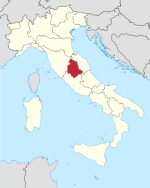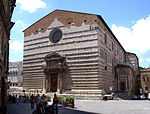Province of Perugia

The Province of Perugia (Italian: Provincia di Perugia) is the larger of the two provinces in the Umbria region of Italy, comprising two-thirds of both the area and population of the region. Its capital is the city of Perugia. The province covered all of Umbria until 1927, when the province of Terni was carved out of its southern third. The province of Perugia has an area of 6,334 km² covering two-thirds of Umbria, and a total population of about 660,000. There are 59 comunes (Italian: comuni) in the province. The province has numerous tourist attractions, especially artistic and historical ones, and is home to the Lake Trasimeno, the largest lake of Central Italy. It is historically the ancestral origin of the Umbri, while later it was a Roman province and then part of the Papal States until the late 19th century.
Excerpt from the Wikipedia article Province of Perugia (License: CC BY-SA 3.0, Authors, Images).Province of Perugia
Piazza IV Novembre, Perugia Sant'Erminio
Geographical coordinates (GPS) Address Nearby Places Show on map
Geographical coordinates (GPS)
| Latitude | Longitude |
|---|---|
| N 43.1121 ° | E 12.3888 ° |
Address
Fontana Maggiore
Piazza IV Novembre
06122 Perugia, Sant'Erminio
Umbria, Italy
Open on Google Maps








